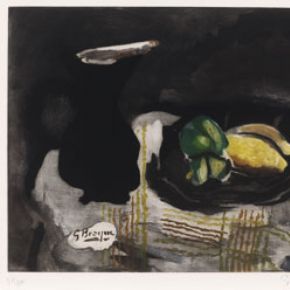乔治·布拉克(Georges Braque,1882—1963),法国立体主义绘画大师,1882年生于塞纳河畔的阿让特伊。他的父亲是位房地产经纪人。1893年,布拉克全家移居勒阿弗尔,他一边在父亲开的油画店作学徒,一边在勒阿弗尔美术学院学习,1902年,他进入巴黎美术学校,受到博纳的指导,后又转入安贝尔学院。他于1904年创办了自己的画室。1905年在参观了秋季沙龙之后,他对野兽派绘画产生浓厚兴趣,遂在以后两年中参加了野兽派绘画运动。不过,他的作品却以其“安祥如歌一样”的基调,与那种色彩强烈、笔法奔放而令人兴奋的地道的野兽派作品风格迥异。之后遇到了对他的艺术起了关键作用的毕加索,这两位伟大画家的协作史也就是立体主义的早期发展史。直到1914年,他们俩亲密合作,创造出自“文艺复兴”发明透视法以来的最具革命性的视觉艺术风格。在生命的最后几年,他创作了两组惊世骇俗的系列作品,即《画室》和《黑鸟》,终被尊崇为20世纪的法国绘画大师。对其早期绘画影响最大的是塞尚和毕加索。他抛弃了印象主义和当时富于装饰性曲线的野兽派风格,减少了过度的色彩,以追求横贯整个画面结构的最大紧凑性。他对立体主义运动早期的大多数重要的技法“发明”都作过贡献,第一个在画面上使用了文字和油彩刷,引进了模仿木纹和大理石纹的过渡法。在颜料里掺进沙子和其它成分以产生各种肌理效果,最后又发明了贴纸法。在材料技法试验上花费了极大的精力。他被公认为本世纪最重要、最具革新精神的静物画家。
布拉克最早将字母糅合进绘画,将颜料与沙子混合作画和使用拼贴画法。晚年作品包括静物画和风景画,风格渐趋现实主义。他对20世纪西方现代派艺术的影响力是很大的。毕加索把他和詹姆斯·乔伊斯并列,称他们是当代“两个最费人猜疑却又人人都能了解的人”。他的影响实际上并不比毕加索小,并且,“立体主义”这一名称还是由他的作品而来。
Georges Braque was a 20th century French painter best known for inventing Cubism with Pablo Picasso.
Georges Braque was a 20th century French painter who invented Cubism with Pablo Picasso. Along with Cubism, Braque
used the styles of Impressionism, Fauvism and collage, and even staged designs for the Ballet Russes. Through his career,
his style changed to portray somber subjects during wartime and lighter, freer themes in between. He never strayed far
from Cubism, as there were always aspects of it in his works. Braque died on August 31, 1963, in Paris.
Georges Braque was a French painter born on May 13, 1882, in Argenteuil, France. He spent his childhood in Le Havre and
planned to follow in the footsteps of his father and grandfather by becoming a house painter. From about 1897 to 1899,
Braque studied painting at the École des Beaux-Arts in the evenings. Wanting to pursue artistic painting further, he moved to Paris and apprenticed with a master decorator
before painting at the Académie Humbert from 1902 to 1904.
Braque started his art career using an Impressionistic painting style. Circa 1905, he transitioned into a Fauvist style after
viewing works exhibited by the Fauves, a group that included such notable artists as Henri Matisse and André Derain. The
Fauves' style incorporated bold colors and loose-form structures to emulate deep emotions.
Braque's first solo show took place in 1908 at Daniel-Henry Kahnweiler's gallery. From 1909 to 1914, Braque and fellow artist Pablo Picasso collaborated to develop Cubism as
well as to incorporate collage elements and papier collé (pasted paper) into their pieces.
Braque's style changed after World War I, when his art became less structured and planned. A successful exhibition in 1922
at the Salon d'Automne in Paris garnered him much acclaim. A few years later, renowned dancer and choreographer Sergei
Diaghilev asked Braque to design decor for two of his ballets at the Ballets Russes. The end of the 1920s saw another style
change as Braque began painting more realistic interpretations of nature, though he never strayed far from Cubism, as there
were always aspects of it in his works.
Braque started to engrave plaster in 1931, and his first significant show took place two years later at the Kunsthalle Basel. He
gained international fame, winning first prize in 1937 at the Carnegie International in Pittsburgh.
The advent of World War II influenced Braque to paint more somber scenes. After the war, he painted lighter subjects of birds,
landscapes and the sea. Braque also created lithographs, sculptures and stained-glass windows.
In 1910 Braque met Marcelle Lapré, a model introduced to him by Pablo Picasso. They married in 1912 and lived in the small
town of Sorgues in southeastern France. During World War I, Braque served in the French army and sustained wounds in 1915.
It took him two years to fully recover.
In his elder years, his failing health prevented him from taking on large-scale commissioned projects. Braque died on August 31, 1963, in Paris.

